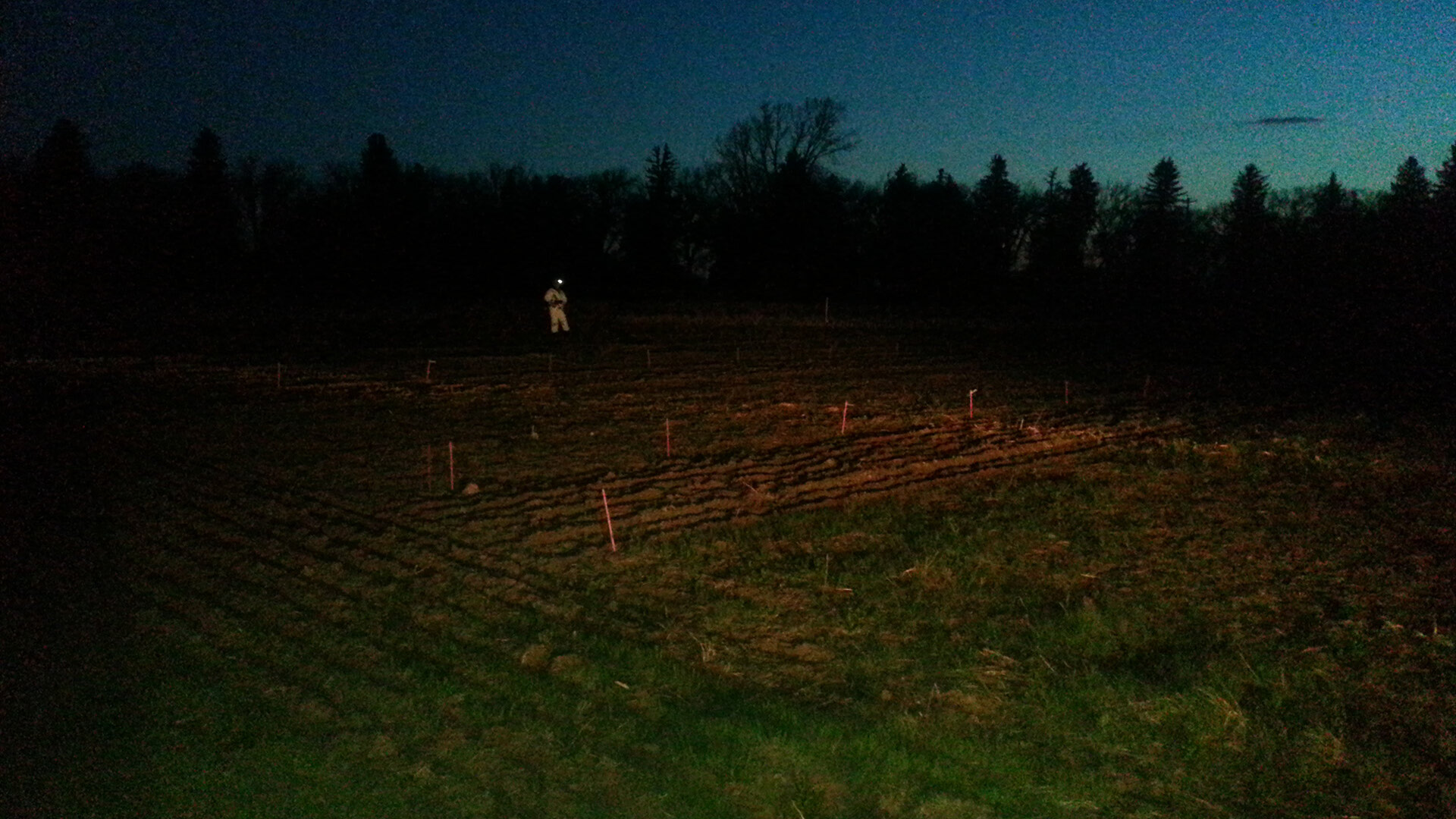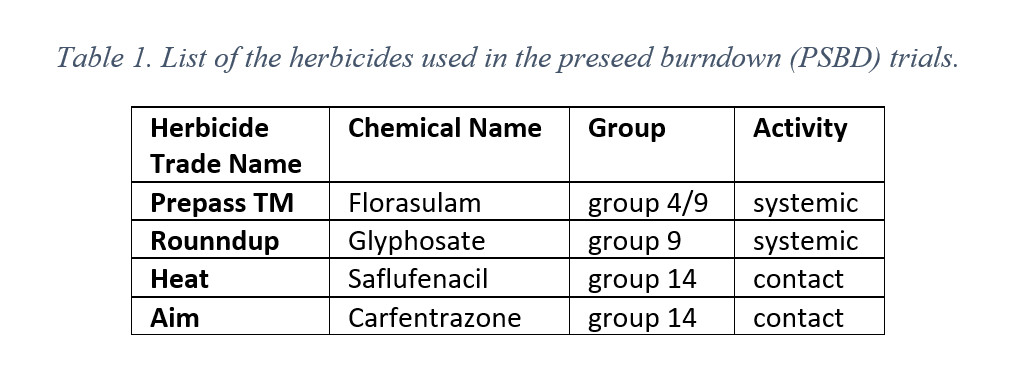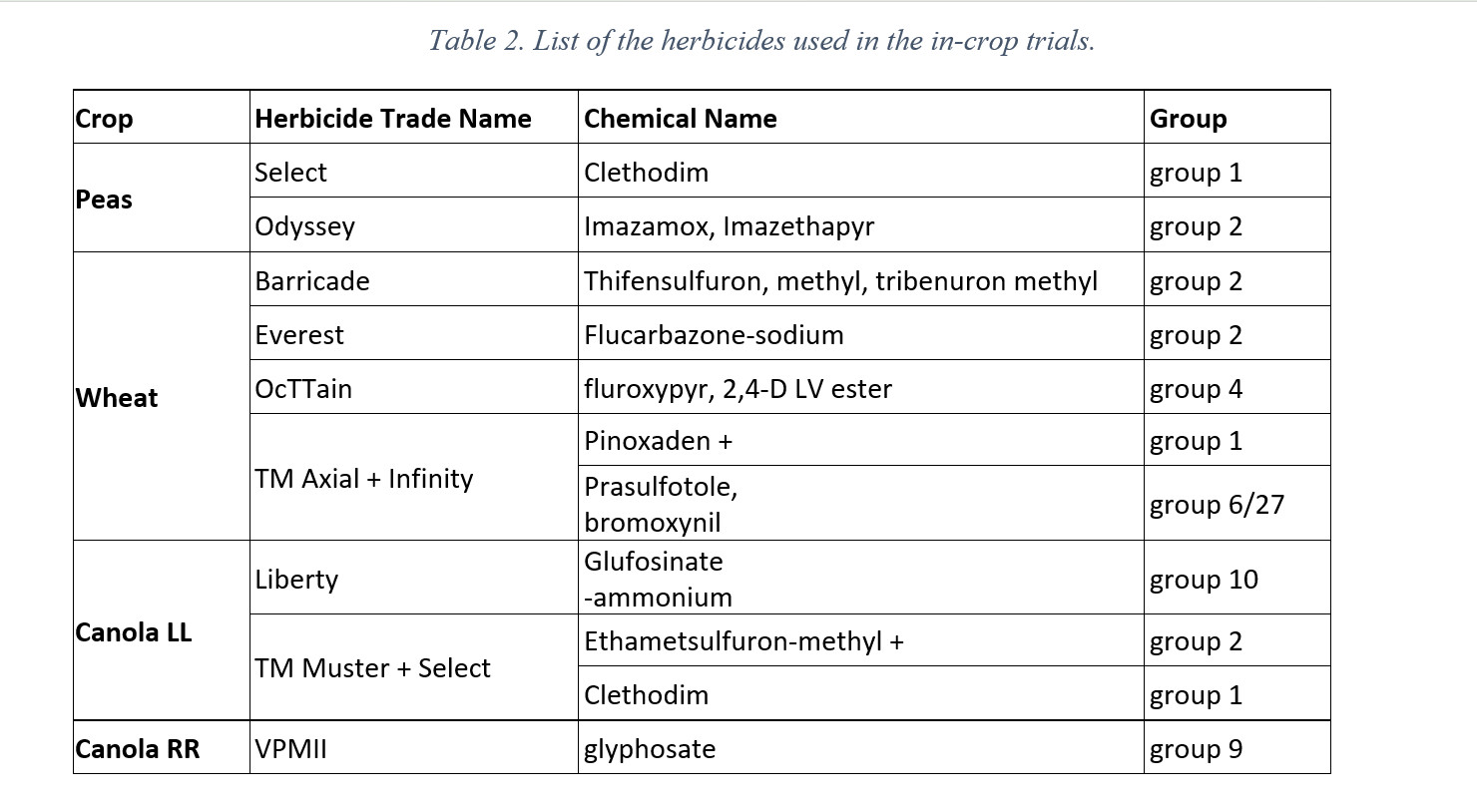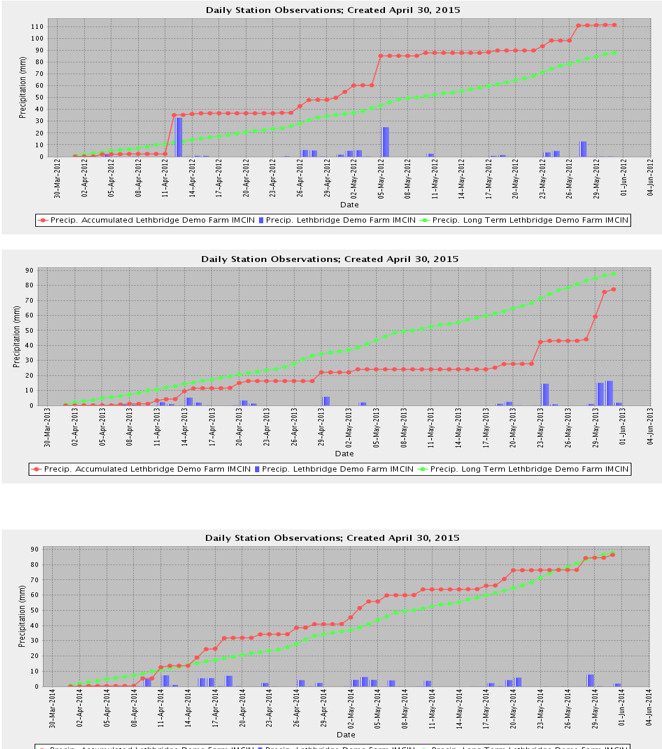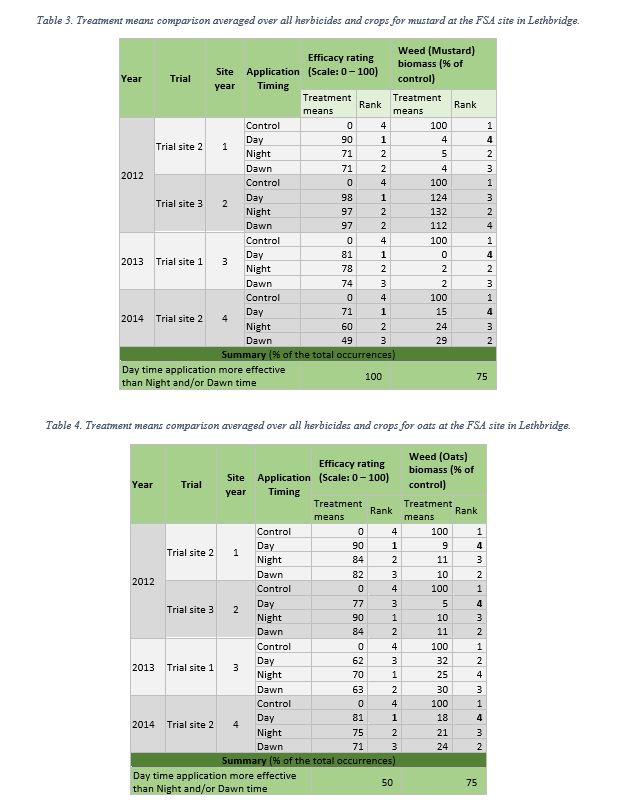BackgroundThis study was initiated to examine night and dawn time pesticide spray applications as a practical alternative to the daytime pesticide application. Poor day time conditions, such as, hot and windy conditions with low humidity and high rates of volatilization and photodegradation, among others, can greatly reduce herbicides' efficacies. Producers rely heavily on pesticides, especially under zero-tillage systems, such that any reduction in herbicides' efficacies can quickly diminish financial returns on their substantial investments. Because of cooler temperatures, less wind, higher humidity and lower evaporation potential, night and dawn time applications are perceived to potentially improve efficacy due to greater absorption while providing a feasible alternative to poor daytime conditions. However, scientific research is limited, and huge knowledge gaps exist in this area. There are hardly any studies available which could provide producers with objective information and tools necessary to make an informed choice and determine if night/dawn time applications could be used as practical alternatives to the daytime application. Therefore, this project was designed to determine if there was a real potential for night or dawn time spraying. This study evaluated day (12-2pm), night (12pm-1am) and early morning (4-5am) spray timings for pre-seed burndown (PSBD) and in-crop herbicide applications. |
|
||||||||||
Project Objectives
|
||||
Methods |
|||||||||
|
Research plots of slightly different sizes were established at three locations, 1.93 m x 6 m at the Farming Smarter Association (FSA) site in Lethbridge, 1.14 m x 6 m at the Lakeland Agricultural Research Association (LARA) site in Bonnyville and 1.37 m x 5 m at the Smoky Applied Research and Demonstration Association (SARDA) in Falher, Alberta. All trials were designed as randomized split-plots with four replicates. Herbicide treatments were the main plots and spry timings were the subplots. Plots were sprayed using handheld sprayers equipped with two-meter booms and CO2 propellant. Low drift nozzles were used at all locations to minimize drift. Herbicide labels were consulted for rates and application timing and other considerations. Nozzles were spaced 50 cm apart and held 50 cm above the canopy. Plot dimensions, number of rows, row spacing etc. were adjusted as necessary to accommodate different seeding and spraying equipment. Preseed burndown (PSBD) trialsThe PSBD trial was conducted only at the FSA site in Lethbridge. Plots were sprayed at label-recommended and three quarter-label rates with four herbicides (Table 1), Prepass (Florasulam), Rounndup (Glyphosate), Aim (Carfentrazone) and Heat(Saflufenacil) according to the experimental design using hand held sprayers equipped with two meter booms and CO2 propellant at three different timings, day (12-2pm), night (12pm-1am) and early morning (4-5am).
Site selection included known weedy areas including both broad leaf and grassy weeds. If these sites were not readily available, weeds were seeded to ensure an effective study. In order to ensure an appropriate range of spray conditions, two trials were conducted with two spray application dates, an early-season date and the most practiced (normal) date. Environmental data were recorded before and after spray applications including air temperature, soil temperature, wind speed and direction, relative humidity, cloud cover, and precipitation. Dew period and evapotranspiration were also measured. Weed control ratings were conducted at 7 DAS (days after spraying), 14 DAS and 21+ DAS. Weed biomass was taken as fresh weights from natural weed infestations using four ¼ m2 quadrats at 21 DAS. The top 5 most prevalent weeds were noted for each plot. Other data collection included growth stage, weeds present and pictures. In-crop trialsIn crop trial locations included FSA, Lethbridge; SARDA, Falher and LARA, Bonnyville, Alberta. Four trials were seeded to barley/wheat, peas, LL-Canola and RR-Canola as early as possible and four additional trials were seeded at a later date to ensure variations in spray conditions. For the same reason, two additional trials were seeded to LL-Canola and RR-Canola on even a later (third) date at the FSA site in Lethbridge. Seeding rates were 300 seeds m2 for barley/wheat, 100 seeds m2 for peas and 5lbs/ha for canola. Tame oats (150 seeds m2) and tame mustard (50 seeds m2) were seeded across the plots in all trials to simulate weeds. Herbicides were selected based on the mode of action, activity, selectivity and use in Alberta (Table 2). Trial plots were sprayed at three quarter-label rate with the herbicides, Liberty (Glufosinate-ammonium), TM Muster + Select (Ethametsulfuron-methyl + Clethodim), Vantage™ Plus MAX II (glyphosate), Odyssey (Imazamox, Imazethapyr), Select (Clethodim), OcTTain (fluroxypyr, 2,4-D LV ester), Everest (Flucarbazone-sodium), Axial + Infinity (Pinoxaden + Prasulfotole, bromoxynil) and Barricade (Thifensulfuron, methyl, tribenuron methyl) depending on the target crop and experimental design, using similar equipment as mentioned above in the PSBD trials.
Measurements
|
|||||||||
ResultsIn majority of the instances in 2012, both daytime and night-time spray applications were more effective than dawn application (Table 3). ERs for both daytime and night-time applications ranked better than the dawn time application for 75% of the time (three of the four herbicides) in Trial 1 and 100% of the time (all four herbicides) in Trial 2. Similarly, in 75% of the occurrences, WBRs for both day- and night-time applications ranked better than the dawn time application in both trials. Results were different, however, in 2013 compared to 2012, particularly in trial 1, where dawn time application ER and WBR ranked better than both day- and night-time in 75% of the instances (Table 4). However, similar to the 2012 results, both ER and WBR for daytime application in trial 2 ranked better than both night-time and dawn applications in 50% and 75% of the instances, respectively. While ER and WBR for the dawn time application on the average scored better than the day and night-time applications in trial 1, results from trial 2 were similar to 2012 favoring the daytime application over the night-time and dawn applications (Table 4). Preseed burndown (PSBD) trialsOn average, PSBD with the daytime application of the selected herbicides was more effective than the Dawn application in 75% of the instances when examined using ERs and about 67% of the time based on the WBRs over the three years, 2012, 2013 and 2014. However, when averaged over 2012 and 2014, the ERs and WBRs values increased from 75% and 67%, respectively, to 94% and 75%, which indicated a substantial increase in the number of instances in which PSBD with the daytime application of the selected herbicide performed better than the dawn time application. The yearly differences in treatment efficiencies can be linked to prevailing weather conditions at the time of herbicide application. A close examination of the weather data in 2013 clearly showed low soil moisture and precipitation shortly after the spray application occurred around the dates of the trials 1 and 2, respectively. Only 24 mm of precipitation had accumulated between April 1 and May 10, 2013, (52% below normal; Figure 1b), indicating a very dry period at the time of the herbicides' application in trial-1 (May 9 and 10, 2013) compared to the 85 mm between April 1 and May 7 (79% above normal) in trial-1 in 2012 (Figure 1a) and 60 mm between April 1 and May 8 (23% above normal) for trial-1 in 2014 (Figure 1c). The impaired performance of all four herbicides due to the dry conditions in 2013 led to WBRs similar to Control (100%) in trial 1 indicating almost no weed kill, and loss of herbicide efficacy.
In-crop trialsThe results at Lethbridge and Falher sites indicated that the daytime spray applications generally performed better than the other timings for all three years of the study. The results at the third site, LARA, were however mixed. The three application timings did not show any advantage over each other for both oats and mustard. herbicides TM Muster+Select and TM Axial+Infinity turned out to be the most effective ones in Canola (LL) and Wheat, respectively. In addition to some apparent weather conditions, such as, temperature inversions and heavy dew on leaves (Enz et al., 2014), reduced interception of herbicides due to the vertical position of leaves at night could also cause substantial decrease in herbicides' efficacies at night and dawn, especially, in the broadleaf weeds exhibiting diurnal leaf movement (Stopps et al., 2013; Mohr et al., 2007). In a study examining the effect of the application time-of-day on glyphosate efficacy on velvetleaf, Mohr et al (2007) indicated that leaf angle and time of application accounted for 82 and 18%, respectively, of the biomass change. In a diurnal cycle, plants keep leaves horizontal relative to stem during the daylight with the maximum leaf surface area exposed to the sunlight and fold them in vertical position parallel to stem during the night. Accordingly, efficacy of an herbicide applied during the day time would be higher because plants with the maximum leaf surface area exposed to the sunlight are more likely to intercept greater amounts of herbicide during the day compared to the night application. However, the diurnal leaf movement phenomenon is not as prevalent in grassy weeds (Mohr et al., 2007). Our results, especially at Lethbridge site, are in agreement with the aforementioned studies showing the effect of diurnal leaf movement (daytime effect) on the herbicide efficacies. When the ER and WBR values were averaged over all herbicides and crops for mustard, a broad leaf weed, the daytime application performed better than the night and dawn timings for all four site years (Table 3). However, for oats, a grassy weed, the daytime application showed better performance than the night and dawn timings in 50 and 75% of the instances for ER and WBR, respectively (Table 4).
|
Recommendations
Since our study results showed a substantial advantage of both day and nighttime applications over the dawn time application, nighttime application could be used as alternative spray application timing for optimizing herbicide use in Alberta, particularly, when the opportunities for daytime application are limited. Because of a short growing season as in Alberta, it is anticipated that the nighttime application of pesticides would significantly expand the time window available for the producers for spray application. It would help producers to avoid potential economic and environmental consequences resulting from waiting for ideal conditions required for daytime application. It would also reduce economic losses from high application rates, unintended damage to off target crops as well as environmental pollution of surface and subsurface water bodies. Relatively calmer and cooler environmental conditions at night would be potentially favorable in limiting off target drifts, reducing high evaporative losses and improving upon plant deposition and adsorption. Project Playlist
|
|||||||||||||

